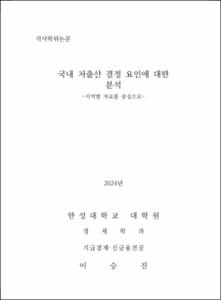국내 저출산 결정 요인에 대한 분석
= Analysis of Low Fertility in Korea: Focused on Regional Data
- Type
- Thesis
- Alternative Title
- -지역별 자료를 중심으로-
- Department
- 대학원 경제학과
- Issued Date
- 2024
- Publisher
- 한성대학교 대학원
- Files in This Item:
-
-
Download
 200000807137.pdf
기타 데이터 / 1.76 MB / Adobe PDF
200000807137.pdf
기타 데이터 / 1.76 MB / Adobe PDF
-
Items in Repository are protected by copyright, with all rights reserved, unless otherwise indicated.